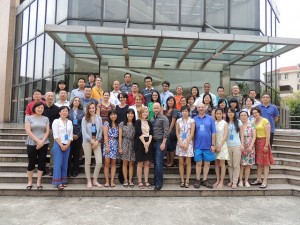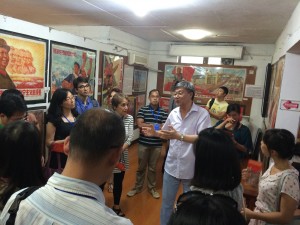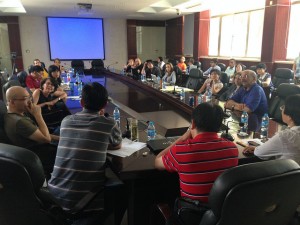What I learned on my (public history) summer vacation
25 September 2014 – Richard Anderson

Participants gathered for a farewell photo on the final day of the seminar on the campus of Shanghai Normal University. Photo credit: Chen Xin
This summer I traveled to Shanghai, China, with a group of fellow students and faculty from Princeton University for an immersive seminar in public history, memory, and preservation. The trip provided an opportunity to think about public history in a transnational framework, which is important to me for two reasons. First, public history remains far too parochial in the United States, despite efforts in many corners of the discipline (and on History@Work’s International Perspectives section) to fashion a more expansive geographic and cultural lens. Second, I’ve been struck by how many of my Princeton classmates most enthusiastic about public history specialize in fields outside North America. As a historian-in-training who studies–and resides in–the United States, I see both a need and a demand for transnational approaches to public history.
I left Shanghai convinced that discussing, let alone practicing, public history with international colleagues requires willingness to adjust one’s assumptions about the discipline and engage in a significant amount of self-reflection. Throughout my week in Shanghai, I felt as though I had discovered a weak muscle in need of conditioning. Yet–to stretch the analogy–once a weak muscle has been developed, it becomes a source of strength. We could enrich our work as teachers, writers, and practitioners by incorporating international perspectives into American public history.
The impetus for our visit to Shanghai came from Na Li, a research fellow at Chongqing University who has been working to bring public history to universities in her native China. Li received her PhD in Urban and Regional Planning at the University of Massachusetts Amherst, where she also completed a graduate certificate in public history. In late July, Li organized a two-week introductory seminar on public history at Shanghai Normal University, where she is an adjunct professor. The seminar brought together Chinese faculty from universities across the country. During the first week, UMass Amherst history professor David Glassberg, led a series of workshops on public history theory and practice, as well as on building curriculum and programming.

Seminar participants receiving an introduction to the Shanghai Propaganda Poster Art Centre from museum director Yang Pei Ming. Photo credit: Richard Anderson
The Princeton contingent arrived for the second week of the seminar, which consisted of site visits and presentations about different facets of public history practice. Our goals were to compare the interpretive challenges that confront practitioners in the US and China, share with our hosts the lessons we had learned through our own public history experiences, and explore possibilities for future collaboration.
The most basic lesson we learned was that transnational dialogue is hard work. Language barriers presented the first challenge. Our group included six Chinese speakers, but the others–especially me!–could only communicate with Chinese colleagues who spoke English. For that reason, I engaged with our hosts on a less substantive level than I had hoped. Language barriers also constrained our seminar discussions. The bilingual members of our group observed that the nuances of individual presentations and participant comments were sometimes lost in translation.
We also encountered differing cultural norms and perspectives, particularly during a visit to the Nanjing Massacre Memorial Hall. The museum commemorates the 1937 Japanese invasion of Nanjing, which remains an open wound in China and a source of significant tension between the two countries. During a talkback session on the bus ride home, several participants from Princeton questioned–gingerly, we thought–the museum’s display of human remains and its interpretive treatment of female rape victims. Many of our hosts understood the criticisms as diminishing the gravity of the Nanjing massacre and dismissing a central piece of Chinese national identity. We had followed the custom of our academic and professional culture–analyzing the curatorial and interpretive choices of a historic site–but we challenged beliefs and collective memories deeply held by many of our Chinese colleagues and appeared arrogant for doing so.
The divergent reactions to the Nanjing Massacre Memorial Museum suggest that each group brought different expectations to that site visit. More broadly, I wonder if we held different expectations for public history itself. My presentation during the seminar framed public history as an explicitly political act that demands sharing authority and challenging dominant narratives. Is this formulation applicable to the Chinese political context? It may be that public historians in China will define the discipline differently than practitioners across the globe.

Participants sharing their thoughts about the seminar during the final wrap-up session. Photo credit: Richard Anderson
I don’t mean to suggest that an unbridgeable chasm separated Chinese and American participants or that unanimity existed within the two contingents. Airing different perspectives during the seminar often proved stimulating and productive. My thoughts nonetheless keep returning to the instances of failed engagement because of what they revealed about my own limitations and biases. Traveling outside of the North American-Western Europe axis for the first time, I was embarrassed by my lack of foreign language skills and chagrined by how much I appreciated finding a Starbucks. I also experienced guilt about my reflexive assumption that–however interesting the debate over the Nanjing museum–our criticisms reflected proper scholarly detachment while those who took offense were captive to nationalist sentiment. We wear blinders of our own in the United States. Large segments of the American public will manifestly not countenance critical analysis of, say, religious doctrine, military institutions, or capitalism. I could cite the Enola Gay controversy and countless others. And what are the ideological red lines American academics and public history professionals will not cross?
I returned from China convinced that the very existence of obstacles to transnational collaboration demonstrates the importance of reaching across geographical boundaries. If we so easily bump up against the limits of our cultural and professional norms, then I fear we will miss opportunities to tell richer, more complex stories that merge the local with the global. We will likewise fail to serve increasingly diverse American audiences. It’s time to work those muscles.
~ Richard Anderson is a doctoral student in twentieth-century American history at Princeton University. He received an MA in public history from the University of Massachusetts Amherst.




Your thoughts are so valuable and this post is so intriguing. I wonder if you could turn it into a series and provide more detail into moments like the Nanjing debate – I feel myself wanting to understand more deeply.
What an experience. Thank you for sharing.
This essay by Richard Anderson on the need for transnational public history is excellent. It’s great to see public history students getting much-needed exposure to and experience with interpretive history in areas outside of North America, and it seems as if there are more and more public history students in the U.S. and Canada who are studying Non-North American history these days.
I observed in this essay, however, that while U.S. public history programs are claimed to be “far too parochial,” the brunt of this criticism seems to be directed towards the American public’s understanding of history rather than addressing specific criticisms of any U.S. public history program. I personally agree that some programs are parochial, but I’d like to hear more about specific issues with parochialism in these programs. For one, I was surprised as a grad student by the aversion of some of my classmates towards studying non-U.S. history topics or analyzing case studies from non-U.S. museums and other cultural institutions during our training.
What, specifically, makes a U.S. public history program “parochial”? What can U.S. programs do to foster an appreciation for transnational public history within their students?